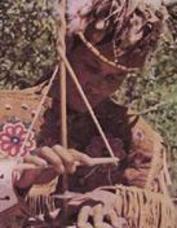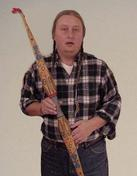Mentors

Mentors Influencing Paul-René's Indigenous Art
During Paul-René’s youth in the 1960′s and 70′s he worked with Woodland Indian artists Tom Two Arrows (Lenape/Onondaga) and Harold Tantaquidgen (Mohegan). These years were also spent with most of his available time in the newly developing “powwow circuit”. During this time Paul-René sang with Ponca (Oklahoma) and Lakota (Northern Plains) style “drums”. Today he feels closest to the music of Eastern Woodland music. He has spent many years in the Northwest both on the Coast and Plateau and the Midwest cultural areas and have incorporated many cultural themes into our work.
Paul-René’s first university experience was at Unity College in Maine where his work study assignment was with the Maine Tribal Unity Museum and Cultural Center Director, Peter Smith Terry. He gained a love and appreciation for ash splint and sweet grass baskets at the center – the Peter Smith Terry Collection was donated by Unity College in 2002 to Abbe Museum which is dedicated now to Wabanaki Nations http://www.abbemuseum.org/pages/collections/collections-overview.html
House made by Ralph Bishop 1997 - Terry inspired Ralph
Ralph "Porcupine" Bishop, Troy Maine, made this house to give to my mother in 1997. We are cousins and both worked with Peter Smith Terry in the Maine Tribal Museum and Cultural center before Peter's death in 1976. Ralph became inspired to help bring back birch bark and quill work while with Peter. This was similar to the inspiration and encouragement given to Paul-René to pursue Northeastern art. Ralph has made many birch bark and porcupine quill work items.


Peter Smith Terry, 1974 – Director of the Maine Tribal unity Museum and Cultural Center (pictured on the left).
Tom Tow Arrows Dorsey also encouraged Paul-René to follow the Northeastern Indigenous culture as many others.
Paul-René met Tom Two Arrows Dorsey at a powwow about 1971. Tom said he was Lenape family heritage but never enrolled. He studied at the Onondaga reservation as a youth. Paul-René was mentored at powwows by Tom learning Woodland style dance, songs, and art. Recently, Tom's background has been questioned as he was not enrolled in a federal or state tribe. This is a common situation for many of the African American/ Indigenous mixed people in the Eastern USA. His intense love for our cultures and art forms inspired many and his work is displayed in several museums.
Paul-René plans to write more about him and is researching and compiling material for a book to give a better understanding of the complex Indigenous identity and cultures formed by mixed communities. Please contact us if you have stories that might shed light on this discussion. We also want to work more with communities of mixed-racial and ethnic background in the Eastern parts of North America who want to record and restore their histories.


The picture on the left is of "No Face" dolls made by Tom Two Arrows – the male doll wears 2 small silver gorgets.
Tom was very detailed in his art referencing our Northeastern culture. Due to his mentoring, Paul-René worked hard to incorporate our cultural art forms into his work. This is now being done by many since about 1990 but was rare in the 1960s to 1980s










